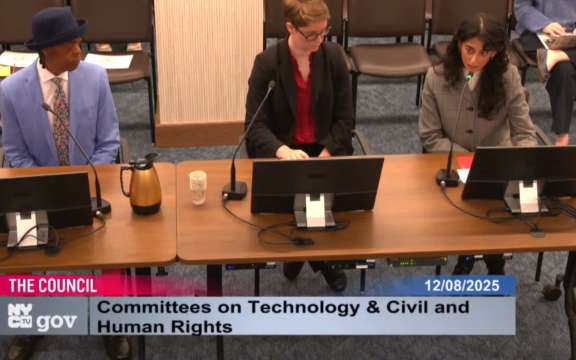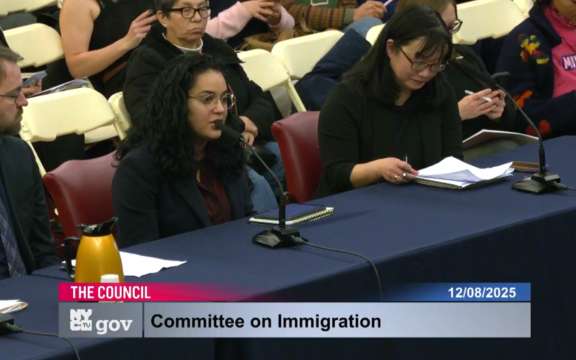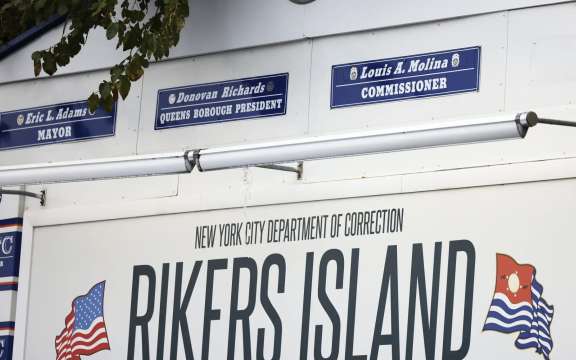BDS Testimony Before New York City Council on the City's Mental Health Emergency Response
TESTIMONY OF:
Joyce Kendrick, Attorney-in-Charge, Mental Health Representation Team
BROOKLYN DEFENDER SERVICES
Presented before New York City Council Committee on Mental Health, Disabilities and Addiction
Oversight Hearing on the City’s Mental Health Emergency Response
February 22, 2021
My name is Joyce Kendrick and I am the Attorney-in-Charge of the Mental Health Representation Team of the Criminal Defense Practice at Brooklyn Defender Services (BDS). Over the last twenty years, I have represented thousands of clients living with mental illness in misdemeanor and felony cases in Brooklyn courts. I want to thank the Committee on Mental Health, Disabilities and Addiction, and in particular Chair Farah Louis, for holding this important hearing on the City’s response to mental health emergencies.
BDS provides multi-disciplinary and client-centered criminal, family, and immigration defense, as well as civil legal services, social work support and advocacy in nearly 30,000 cases in Brooklyn every year. Our Mental Health Representation Team works to support people living with serious mental illness (SMI) who have been accused of a crime in Brooklyn, representing clients at competency evaluations, hearings and other court appearances during the pendency of their case. In addition, these specialized attorneys regularly consult with others in the criminal defense practice to advise on mental health concerns in their cases and provide internal expertise to all of BDS’ criminal defense attorneys. We are also proud of having played an important role in the creation of the Brooklyn Mental Health Court in 2002. The Brooklyn Mental Health Court works with defendants who have serious and persistent mental illnesses, linking them to long- term treatment as an alternative to incarceration. BDS continues to collaborate with this court to advocate for its expansion to meet the needs of more people, including people with intellectual disabilities and people who have previous criminal legal system involvement.
Emergency Response
For too long, our City has relied on policing and jails to address issues of mental illness and substance abuse. Individuals experiencing a mental health crisis are more likely to be engaged by police than medical providers.1 Across the country, jails and prisons have become the largest provider of health care, including mental health care. New York City is no exception.
Instances where the police respond to mental health crises often end in abuse or even death, such as in the case of the NYPD killing of Kawaski Trawick in his own home.2 A 2015 report from the Treatment Advocacy Center found that one in four people killed by police had untreated SMI and that one in every ten calls to police were related to a person with untreated SMI.3 People experiencing mental health crises who survive their encounters with responding police are often criminalized and subjected to other forms of misconduct. According to the United States Department of Justice’s Bureau of Justice Statistics, roughly one out of every four people in jail met the threshold for severe psychological distress within the prior 30 days, as compared to just 5% of the general population.4 According to the American Psychological Association, at least half of all incarcerated people live with a mental illness.5 Similarly, people who are unhoused and/or struggling with substance use disorder are more likely to encounter the police and be incarcerated6—without having their needs met.
Policing is demonstrably ableist in application; officers respond to people with disabilities with disastrous consequences. Police kill people with autism, people who are deaf or cannot follow verbal commands, people who are neurodivergent, and other people with special needs at much higher rates than the general population; studies show that between 30% and 50% of all people killed by the police have a disability.7 This stark disparity is also reflected in the numbers of people who are arrested by police and incarcerated. According to another study by the Bureau of Justice Statistics, roughly 40% of people in jail and 32% of people in prison reported having at least one disability.8 Simply put, building NYPD response into plans to address mental health crises ensures further disparate impacts and harm to people with mental health needs.
Int 2210-2021 – Creating an office of community mental health and a citywide
BDS supports the spirit of Int 2210-2021 in relation to creating an office of community mental health and a citywide mental health emergency response protocol. Families and caretakers of people living with mental illness often feel that they have nowhere to turn when their loved ones are in the midst of a mental health crisis. They recognize that calling 911 to report a mental health crisis will likely trigger a response by NYPD and potentially place their loved one in danger.
For years, BDS has called for a non-police response to mental health emergencies and the expansion of mobile crisis teams.9 We are hopeful that this program will be successful and remove the burden from caretakers who have too often struggled to access mental health support and care for their loved ones due to fear of police escalation during a crisis.
We respectfully offer the following recommendations to strengthen the legislation and continue to shrink the scope of NYPD response to mental health emergencies:
1. Remove NYPD from all mental health responses and create accountability measures for inappropriate NYPD responses
The proposed legislation allows NYPD to respond in cases that are indicated to be a “public safety emergency” though indicates that NYPD officers should “refrain from engaging with an individual in mental health crisis unless instructed to do so by a member of the office of community mental health.” As written, the definition of public safety emergency10 is too broad and may result in police being dispatched to almost any call.
Allowing the NYPD to continue responding to these calls—even with additional training—does not address the real danger that police pose to people experiencing mental health crises, nor does it prevent the criminalization of mental illness. Police are not mental health experts or medical professionals, nor should they be tasked with filling this role. The legislation specifically assigns to the NYPD the responsibility of training police officers to respond to people in emotional crisis and collaborate appropriately with the Mental Health emergency response teams. We disagree that more resources should be allocated to the NYPD for this training when the purpose of this bill is to limit the NYPD’s role in responding to New Yorkers in emotional distress.
Additionally, the bill lacks any real measures for accountability for the NYPD. The spirit of this legislation is to remove NYPD from mental health responses, recognizing the traumatic and sometimes fatal consequences of NYPD response and escalation. While this bill includes a mechanism for reporting on which agencies report to a mental health emergency, it remains unclear what will happen if NYPD inappropriately responds or escalates. There must be clear accountability measures for wrongful police response included in any legislation intended to protect people experiencing a crisis when emergency services are requested.
2. Include stakeholders in the Office of Mental Health emergency response planning process
Int 2210-2021 requires the City to establish an Office of Mental Health and develop a citywide mental health emergency response protocol. The establishment of this protocol must include stakeholders including people living with serious mental illness, people who have experienced NYPD response to a crisis, community mental health providers, and public defenders.
While the legislation calls for the inclusion of many City organizations in the response procedure—including DOHMH, NYPD, ACS, and others—there is no requirement for the City to include people living with serious mental illness or their loved ones. It is critical that people who have lived experience with the current emergency response system be able to share their stories and help shape what comes next. Additionally, because the NYPD is still included in the response to some emergencies under this proposal, BDS encourages the Council to include public defenders, community mental health practitioners, and mental health advocates who have a unique perspective on the impact of police response to people in crisis.
Int 2222-2021 - Creating a 3-digit mental health emergency line
BDS supports Int 2222-2021 which would create a specialized 3-digit mental health emergency line staffed by mental health professionals, in addition to allowing calls for mental health emergency response to be routed to mental health providers through both 911 and 311.
The existing mistrust of NYPD will not be eliminated by the creation of an emergency mental health team. Families and social workers report calling 911 to ask for EMTs to respond to an emotional health crisis but receiving a police response, which escalated a crisis. The creation of another line—and the ability to call 311—will ideally give people in crisis and their loved ones a sense of safety when seeking help. Additionally, a trained mental health provider may be able to provide a brief crisis intervention while on the phone, assess for suicidality, offer supportive counseling, and help someone regulate their emotions and return to a pre-crisis state. A call to a 3-digit emergency mental health line may provide an opportunity to for people in crisis to avoid hospitalization or arrest, stay in their homes, and be connected to community-based care.
Additional Recommendation
Creating a comprehensive plan for emergency response to mental health emergencies is crucial for the City, but this initiative must be coupled with increased support for people living with serious mental illness – including expanded respite centers, access to culturally competent mental healthcare, and the creation of additional supportive housing units.
Provide more respite centers and crisis beds for people with mental illness
Many of the people we serve would not have become court involved if there was a safe place they could go to stay, access medications, and get the support of mental health professionals while addressing a short-term crisis or mediating a concern with a family member or caretaker. While crisis respite centers are available, restrictive policies often prevent people who are court involved, suicidal, or deemed to be acting erratically to access beds. People with SMI could be invaluably served if there were safe, well-known respite centers where adults with mental illness could stay when experiencing a crisis that does not require hospitalization.
In current practice, when NYPD responds to a mental health emergency the person in crisis is handcuffed and transported to a hospital for evaluation or a police precinct. The establishment of a mental health response team must be coupled with additional resources to meet the needs of people in crisis outside of the emergency room or a jail.
The Governor has included funding for a stabilization centers in his budget proposal and the City has discussed the need for these services for many years. These centers must be opened, fully funded, and equipped to meet the needs of people who choose to access care in crisis, are ready to engage in treatment and need help to stabilize as they engage in care, as well as individuals who transported by a mental health response team or NYPD. We believe these spaces should be accessible in areas with the highest rates of emergency mental health calls and operated by trusted, community-based organizations, so people in crisis can remain in their own neighborhoods near their support systems.
Close treatment gaps for individuals with serious mental illness
We recognize a need for high quality, trauma informed therapy and psychiatry services for adults with SMI. Inadequate community-based mental health and substance use treatment funnel people struggling with mental illness into handcuffs, jails and prisons. For these individuals, time in City jails frequently exacerbates preexisting mental illness, as behavioral health needs are all too often met with violence and isolation rather than appropriate care. After serving time in jail or prison, people who return to their communities frequently lack adequate healthcare infrastructure and affordable and supportive resources. These inadequacies lead to people falling through the cracks and too often tragic results – either irreversible sickness and death or the churning cycle of incarceration, lapses in treatment, homelessness, and recidivism.11
In order to ensure that every New Yorker is able to access the care they need, we ask that the City expand evidenced-based treatments available to people with severe mental illness before they are engaged in the criminal legal system. This includes expanding access to Assertive Community Treatment (ACT) and Forensic Assertive Community Treatment (FACT) teams, investing in community based mental health treatment programs in low-income communities, and frontline workers—including Health Home care navigators and NYC Well phone-based counselors—on available mental health care options for New Yorkers with severe mental illness.
Increase access to culturally competent, trauma informed providers
Cultural competency is a major barrier to services for many New Yorkers with mental health needs. The existing outpatient mental health programs are not equipped to address the extreme trauma and hardship faced by the people we serve. Receiving mental health care has cultural barriers and stigma for many of our clients. For people who do not speak English, are LGBTQ, have been incarcerated, or do not see their race or ethnicity reflected by providers, receiving mental healthcare that is affirming and culturally competent can feel impossible. For clients with complex trauma histories, the available low-cost mental health clinics do not have the competency or scope of services needed to treat our clients.
We urge the City to invest in free and low-cost mental health services that are designed for people who have experienced hardship, trauma, or incarceration. These programs must be equipped to meet the needs of people who are newly being introduced to mental health care, to create a familiar, nonthreatening therapeutic environment for those who may be hesitant to engage in treatment. Such programs must employ trained clinicians who are fluent in multiple languages. We must not place the burden on the patient to educate the clinician about the realities of incarceration, gun violence, or racism.
Expand access to supportive and affordable housing
People with serious mental health concerns are disproportionately homeless or housing insecure, which creates additional barriers to for people to access the treatment they need to manage their mental illness. People experiencing homelessness may have difficulties connecting to providers, affording treatment or medication, or accessing transportation to appointments.
In the midst of the COVD-19 pandemic, some of the people we serve have been released from City jails or hospitals and placed in emergency hotels. This setting has proven life changing for some of the people with serious mental illness we serve. In lieu of a loud, chaotic and often violent congregate shelters, people have private rooms in clean, comfortable buildings where they are treated with dignity and respect. One client—who has struggled to manage his mental illness while living on the streets—has been in a hotel for several months. In this time, he has been connected to voluntary mental health services, stabilized on his medications, and is able to remain in communication with our office and his treatment team to complete his court mandated programs. The stability and safety of a clean, safe environment where he has access to supportive services on site has changed his life. The City must work to expand access to supportive housing for people with serious mental illness or substance use disorders, as well as ensure access to affordable housing for all.
Conclusion
BDS is grateful to the Committee on Mental Health, Disabilities and Addiction for hosting this critical hearing and shining a spotlight this issue. Thank you for your time and consideration of our comments. We look forward to further discussing these and other issues that impact the people and communities we serve.
If you have any questions, please feel free to reach out to Kathleen McKenna, Senior Policy Social Worker at 718-254-0700 x210 or kmckenna@bds.org.
1 National Alliance on Mental Illness, Jailing people with mental illness, 2019, Available online: https://www.nami.org/Learn-More/Mental-Health-Public-Policy/Jailing-People-with-Mental-Illness
2 https://www.propublica.org/article/it-wasnt-the-first-time-the-nypd-killed-someone-in-crisis-for-kawaski-trawick- it-only-took-112-seconds
3 Fuller, Doris & Lamb, H. & Biasotti, Michael & Snook, John. (2016). Overlooked in the Undercounted: The Role of Mental Illness in Fatal Law Enforcement Encounters. 10.13140/RG.2.1.1655.9128
4 Jennifer Bronson, Ph.D, Report: Indicators Of Mental Health Problems Reported By Prisoners And Jail Inmates,
U.S. Dept. of Justice, Bureau of Justice Statistics, available at:https://www.bjs.gov/index.cfm?ty=pbdetail&iid=5946.
5 Collier, L. (2014, October). Incarceration nation. Monitor on Psychology, 45(9). http://www.apa.org/monitor/2014/10/incarceration.
6 NIDA. 2020, June 1. Criminal Justice DrugFacts. Retrieved from https://www.drugabuse.gov/publications/drugfacts/criminal-justice (last accessed February 1, 2021).
7 Abigail Abrams, “Black, Disabled and at Risk: The Overlooked Problem of Police Violence Against Americans with Disabilities,” Time Magazine (June 25, 2020) https://time.com/5857438/polic....
8 Jennifer Bronson, Ph.D., Laura M. Maruschak, BJS, and Marcus Berzofsky, Dr.P.H., Special Report: Disabilities Among Prison and Jail Inmates, U.S. Dept. of Justice, Bureau of Justice Statistics, available at: bjs.gov/content/pub/pdf/dpji1112.pdf
9 See our prior testimony on this topic at www.bds.org/policy
10 Public safety emergency. The term “public safety emergency” means a crime in progress, violence, or a situation likely to result in imminent harm or danger to the public, as defined by the office.
11 The National Commission on Correctional Healthcare has recognized these dangers. See Nat’l Comm. On Corr. Healthcare, About Us, https://www.ncchc.org/about (recognizing that improving the quality of care in jails and prisons not only “improve[s] the health of their inmates,” but also “the communities to which they return”)


